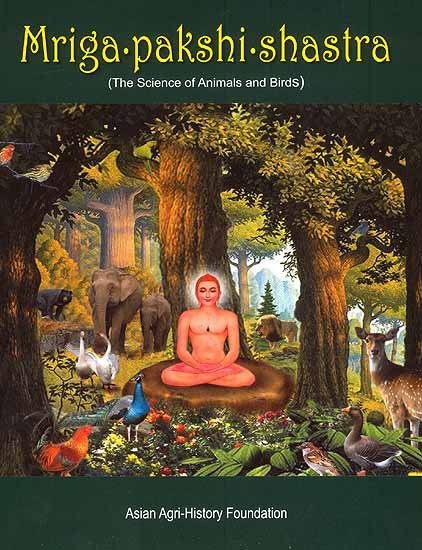Animal Kingdom (Tiryak) in Epics
by Saranya P.S | 2019 | 51,616 words | ISBN-10: 8190396315 | ISBN-13: 9788190396318
An English study the Animal Kingdom (Tiryak) in Epics.—The present thesis is based entirely on Ramayana and Mahabharata although an attempt is made to analytically compare the Animal kingdom with Mriga-pakshi-shastra—‘The ancient Indian science of of Animals and Birds’....
Chapter 4.29 - The Kraunca (Demoiselle crane) in the Epics
There are various cultural concepts regarding cranes in different countries. They are pet birds and are figured in poetry. The bird has a legendary place in literature. When Valmiki was moved by the tragic killing of such a bird by a hunter, the painful incident proved to be the inspiration to him to compose the great epic Ramayana.
There are detailed descriptions about this bird in the Ramayana. It would be quite appropriate to say that the root cause for the writing of Adikavya was actually this bird.Valmiki calls this bird with different names that include ‘Kukara’, ‘Titibhi’, ‘Koyashti’ and ‘Tittari’.
A famous verse in the Ramayana refers to the pair of cranes, most probably the Sarasa crane. Valmiki got his inspiration when he saw the lamenting bird. The glorious sage actually perceived in that forest a pair of cranes moving about, never parting from one another, and making a charming noise.”[1]
“A female bird wailed when she as separated from her mate and companion; the bird that was endowed with a coppery head was inflated with passion and courting had distended its wings.”[2]
“May you not have peace of mind for endless years, fowler, since you have killed one of the pair of cranes, infatuated with passion.”[3]
In the Valmiki Ramayana we find so many references about the cranes and their association with lakes and rivers. The Pampa Sarovara was said to be charming with aquatic birds singing melodiously.[4] The Sahya Mountains were said to be inhabited by the ducks and cranes[5]. The palace of Queen Kaikeyi was said to be full of the musical notes of cranes and swans.[6]
While describing the fight between Indrajit and Lakshmana, it is said,
“While being stretched at full length of violence by their arms, which resembled a pair of iron bludgeons, the excellent bows of the two warriors, for their part, emitted a piercing sound like a pair of cranes.”[7] (The quality of the sound suggested here may be related to the demoiselle crane.)
Sometimes the name of the crane is mentioned in Sanskrit literature to suggest their migration. For example, we read:
“Pellucid water smiling joyfully in the form of flowers and made noisy with the cries of cranes, fully ripe paddy fields, may the gentle breeze and the cloudless moon broken the time of passing away of the rains.”[8]
The cranes mentioned here might be demoiselle cranes or common cranes which are winter migrants. In the ValmikiRamayana, various types of flight with respect to height are discussed,[9] where cranes and ospreys are said to be third in the order of height.
In the epic Mahabharata we find a different metaphor.
“The net of the arrow spread in the sky looked red and fierce like the upper body of the crane”.[10]
Krauncadvipa is one of the seven islands. There is a mountain here called Kraunca. A mythological story is related to this name. The story is found in the Mahabharata.[11]
One of the Ganas or Attendantsof Lord Siva is said to be crane faced. There is a holy place named Krauncapadi where it is prescribed that one should offer panda to become pure. In the Mahabharata there is a belief that the sight of cranes is auspicious.[12]
“One who insults the elder brother equal to one’s father is born as the Kraunca after his death.One who steals a cotton cloth will become a cane in his next birth.”[13]
There are a lot of fantastic superstitions about Kraunca in the Sanskrit literature. In the Mahabharata we read that the goddess Lakshmi lives in the rivers which resound with the calls of the Sarasa cranes.[14]
They have white wings. They have long reddish legs and beaks. They have bulky bodies and they appear rugged. They produce a throaty 'kenkara' and have a faltering gait. They have powerful wings and can fly long distances. They are sluggish by nature. They squawk in a faint tone and move in flocks. They become very aggressive when hungry and can kill rival birds. They love eating meat and sporting in water. They are different coloured marks on their bodies. They are supposed to dull-witted. They can be tamed by man and can be a source of great joy for them.
Footnotes and references:
[1]:
Valmiki Ramayana .I.2.9
[2]:
Ibid.I.2.12c
[3]:
Ibid.I.2.14
[4]:
Ibid.IV.1.43
[5]:
Ibid.VI.4.85
[6]:
Ibid.II.10.12
[7]:
Ibid.VI.90.51
[8]:
Ibid.IV.30.53
[9]:
Ibid.IV.58.26-29
[10]:
Mahabharata .8.35.45c
[11]:
Ibid.III.214.31a.
[12]:
Ibid.10.7.19c
[13]:
Ibid.13.112.77a
Ibid.13.112100c
[14]:
Ibid.13.11.15c
